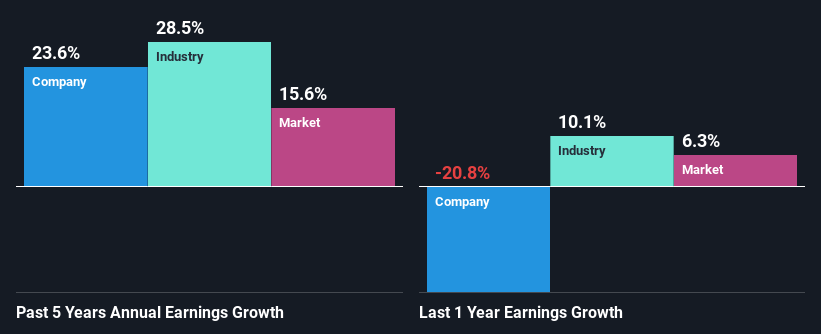Declining Stock and Solid Fundamentals: Is The Market Wrong About Thermo Fisher Scientific Inc. (NYSE:TMO)?
Thermo Fisher Scientific (NYSE:TMO) has had a rough three months with its share price down 7.2%. However, a closer look at its sound financials might cause you to think again. Given that fundamentals usually drive long-term market outcomes, the company is worth looking at. Particularly, we will be paying attention to Thermo Fisher Scientific's ROE today.
Return on equity or ROE is a key measure used to assess how efficiently a company's management is utilizing the company's capital. In simpler terms, it measures the profitability of a company in relation to shareholder's equity.
View our latest analysis for Thermo Fisher Scientific
How Do You Calculate Return On Equity?
The formula for return on equity is:
Return on Equity = Net Profit (from continuing operations) ÷ Shareholders' Equity
So, based on the above formula, the ROE for Thermo Fisher Scientific is:
14% = US$6.0b ÷ US$42b (Based on the trailing twelve months to April 2023).
The 'return' is the yearly profit. That means that for every $1 worth of shareholders' equity, the company generated $0.14 in profit.
Why Is ROE Important For Earnings Growth?
Thus far, we have learned that ROE measures how efficiently a company is generating its profits. We now need to evaluate how much profit the company reinvests or "retains" for future growth which then gives us an idea about the growth potential of the company. Assuming everything else remains unchanged, the higher the ROE and profit retention, the higher the growth rate of a company compared to companies that don't necessarily bear these characteristics.
Thermo Fisher Scientific's Earnings Growth And 14% ROE
To begin with, Thermo Fisher Scientific seems to have a respectable ROE. Even when compared to the industry average of 14% the company's ROE looks quite decent. This certainly adds some context to Thermo Fisher Scientific's exceptional 24% net income growth seen over the past five years. We believe that there might also be other aspects that are positively influencing the company's earnings growth. For example, it is possible that the company's management has made some good strategic decisions, or that the company has a low payout ratio.
We then performed a comparison between Thermo Fisher Scientific's net income growth with the industry, which revealed that the company's growth is similar to the average industry growth of 29% in the same period.
The basis for attaching value to a company is, to a great extent, tied to its earnings growth. It’s important for an investor to know whether the market has priced in the company's expected earnings growth (or decline). Doing so will help them establish if the stock's future looks promising or ominous. One good indicator of expected earnings growth is the P/E ratio which determines the price the market is willing to pay for a stock based on its earnings prospects. So, you may want to check if Thermo Fisher Scientific is trading on a high P/E or a low P/E, relative to its industry.
Is Thermo Fisher Scientific Using Its Retained Earnings Effectively?
Thermo Fisher Scientific has a really low three-year median payout ratio of 5.8%, meaning that it has the remaining 94% left over to reinvest into its business. This suggests that the management is reinvesting most of the profits to grow the business as evidenced by the growth seen by the company.
Moreover, Thermo Fisher Scientific is determined to keep sharing its profits with shareholders which we infer from its long history of paying a dividend for at least ten years. Based on the latest analysts' estimates, we found that the company's future payout ratio over the next three years is expected to hold steady at 4.9%. However, Thermo Fisher Scientific's ROE is predicted to rise to 22% despite there being no anticipated change in its payout ratio.
Summary
On the whole, we feel that Thermo Fisher Scientific's performance has been quite good. In particular, it's great to see that the company is investing heavily into its business and along with a high rate of return, that has resulted in a sizeable growth in its earnings. Having said that, the company's earnings growth is expected to slow down, as forecasted in the current analyst estimates. To know more about the latest analysts predictions for the company, check out this visualization of analyst forecasts for the company.
Have feedback on this article? Concerned about the content? Get in touch with us directly. Alternatively, email editorial-team (at) simplywallst.com.
This article by Simply Wall St is general in nature. We provide commentary based on historical data and analyst forecasts only using an unbiased methodology and our articles are not intended to be financial advice. It does not constitute a recommendation to buy or sell any stock, and does not take account of your objectives, or your financial situation. We aim to bring you long-term focused analysis driven by fundamental data. Note that our analysis may not factor in the latest price-sensitive company announcements or qualitative material. Simply Wall St has no position in any stocks mentioned.
Join A Paid User Research Session
You’ll receive a US$30 Amazon Gift card for 1 hour of your time while helping us build better investing tools for the individual investors like yourself. Sign up here

 Yahoo Finance
Yahoo Finance 
